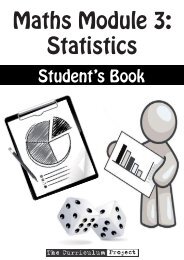Download - The Curriculum Project
Download - The Curriculum Project
Download - The Curriculum Project
Create successful ePaper yourself
Turn your PDF publications into a flip-book with our unique Google optimized e-Paper software.
B. Pre-teach surrounded by. Students choose six Southeast Asian countries, and write sentencesdescribing them. Let students correct each other’s descriptions, or work in groups to negotiateaccurate descriptions.Possible answers:Burma is a fairly large country in Southeast Asia, north-west of Thailand, next to the AndamanSea.Thailand is a fairly large country south-east of Burma, between the Andaman Sea and the SouthChina Sea.Laos is a long, narrow country west of Thailand and east of Vietnam.Vietnam is a long, narrow country south of China, with its east coast on the South China sea.Cambodia is a fairly small country which has borders with Thailand, Laos and Vietnam.<strong>The</strong> Philippines is a large group of islands in the South China Sea.Malaysia has two parts: one part is south of Thailand, and the other is the north part of an islandin the South China Sea, west of the Philippines.Singapore is a very small country south of Malaysia.Brunei is a very small country on the South China Sea, surrounded by Malaysia.Indonesia is a very large group of islands, mostly in the Indian Ocean.East Timor is a small country in the Indian Ocean, surrounded by Indonesia.C. Students look at the world map at the back of the book, or another world map, and each choose acountry (not one of the six they wrote about in B). In pairs, they describe this country to their partner.<strong>The</strong>ir partner identifies the country.After a few turns at this, get a few students to describe a country to the class. <strong>The</strong> class identifiesthe country.3.2 Weather and climateA. Elicit the difference between weather and climate (weather is happening now; climate is the typeof weather a region gets throughout the year). Discuss tropical climate. Elicit an explanation fromstudents. Discuss the other questions.Answers: Tropical climates are hot and wet. Countries near the equator often have tropical climates.B. Discuss temperate climates, and elicit students’ answers to the questions.Answers:Temperate climates have four seasons: winter, spring, summer, autumn. Winter is cold and wet,and summer is hotter and less wet. Temperate climates have no rainy season – it can rain at anytime of year. Countries that are not near the equator, but not near the North and South Poleseither, have temperate climates, e.g. the UK, southern New Zealand and western USA.C. In pairs or individually, students answer these questions. <strong>The</strong>y should use their dictionaries if theyget stuck.Answers:1. Damp, usually hot and sticky weather.2. <strong>The</strong>re are two – Celsius (also called centigrade; water freezes at 0 degrees and boils at 100degrees) and fahrenheit (water freezes at 32 degrees, and boils at 212 degrees).3. Winter 5. Very light clothes – this is extremely hot!4. Cold. It snows in the mountains. 6. heaters, stoves, fires, radiatorsD. Pre-teach small talk (casual conversation about unimportant things). Establish that in some Englishspeakingcountries the weather is a very common conversation topic amongst strangers or people whodon’t know each other very well, as it is something everybody can discuss easily.Read the situations, and clarify anything students don’t understand. Students write some things theycould say in each situation. Get students’ ideas, and make class lists on the board.Possible answers:1. It’s too hot! It’s boiling today, isn’t it? I hate/love this weather.2. It’s very cold, isn’t it?! It’s freezing! This wind is strong, isn’t it?3. Why is it raining now? That’s strange! It’ s very wet outside!46 Module 11



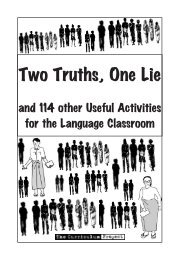


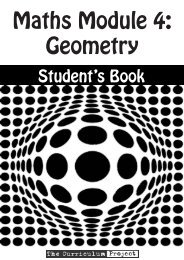

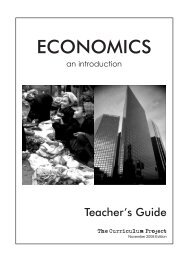
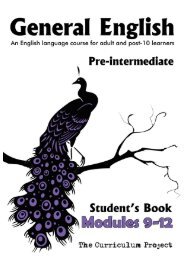

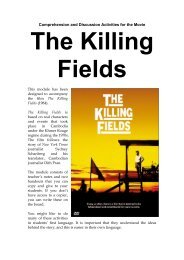
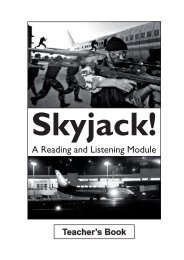
![[Eng] Nov 2012 DRAFT - The Curriculum Project](https://img.yumpu.com/45590859/1/184x260/eng-nov-2012-draft-the-curriculum-project.jpg?quality=85)


